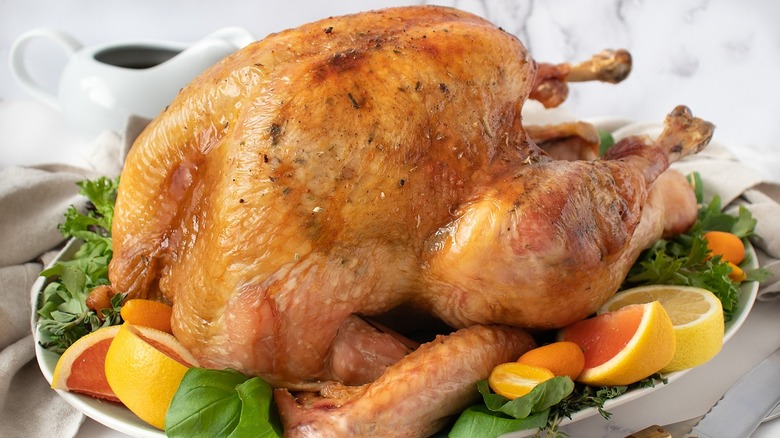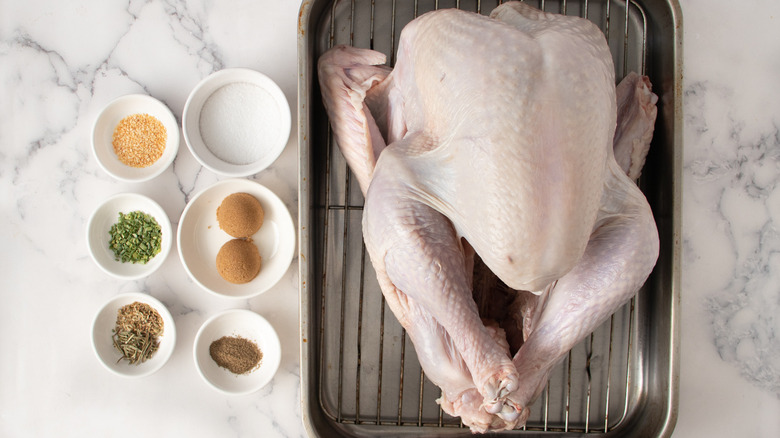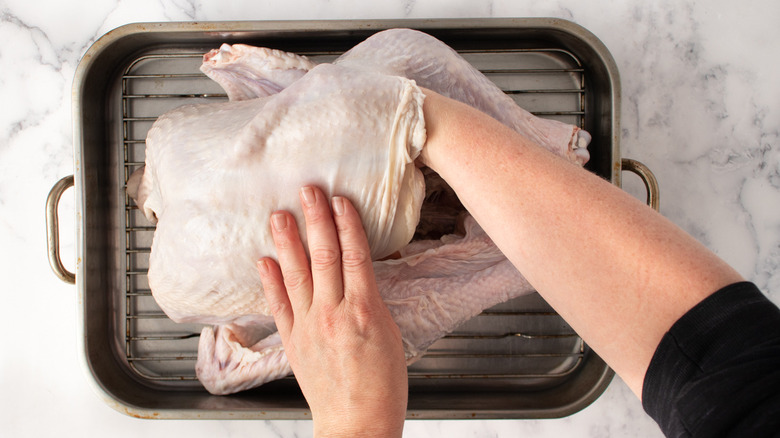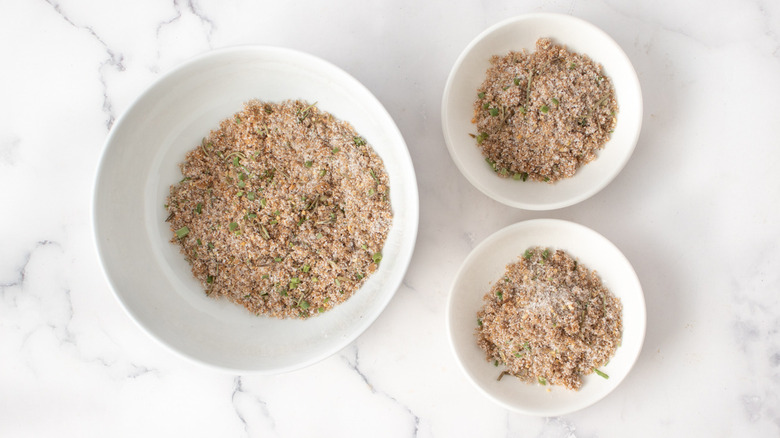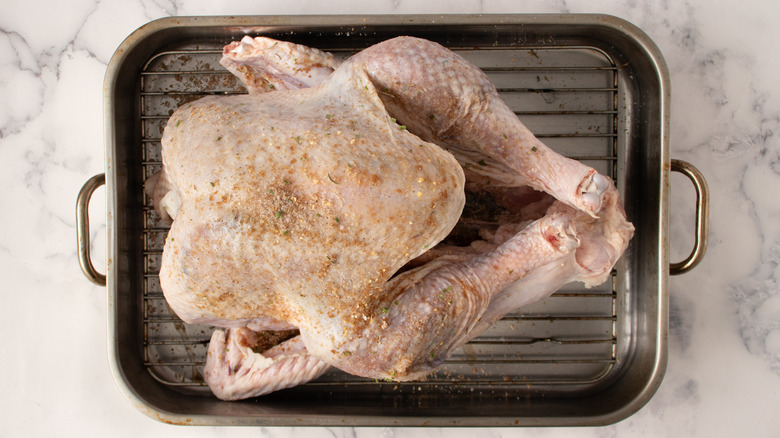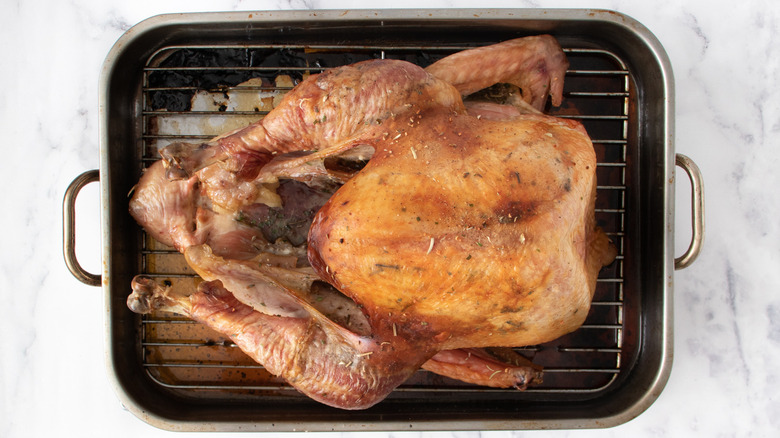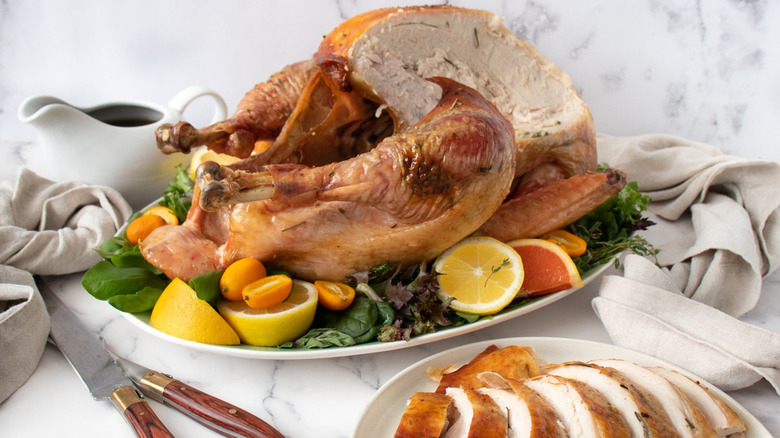Dry-Brined "Evergreen" Roast Turkey Recipe
Roast turkey is inherently linked with Thanksgiving, but that leaves bird lovers with 364 other days of missed opportunities to enjoy it. Sure, it's a process to roast a whole bird, but there's no reason why turkey needs to be limited to a big holiday meal. Mashed recipe developer Patterson Watkins shares this dry-brined evergreen roast turkey recipe, you're going to want to make this at least a few times per year — whether or not it's a national turkey-eating holiday. She agrees and comments, "We gotta bust the humble turkey out of its holiday-only cage. It is a super adaptable, evergreen protein."
A simple blend of classic herbs is used to season the giant bird, infusing it with delicious aromas that won't need to compete with cranberry sauce. As Watkins shares, "the savory, sweet, and herbaceous elements of the dry brine mixture [are] super balancing and flavorful." She goes on to explain that "Brines are a super special, chef secret 'ingredient' that can do far more than simply preserve food. Brining infuses proteins with flavor as well as protects [and] locks in moisture, making your turkey tasty as well as juicy."
You'll have to plan ahead and make some space in your refrigerator for this recipe since it requires three days of brining. However, once it's roasted you'll be rewarded for your patience with a succulent turkey dish.
Gather the ingredients for this dry-brined evergreen roast turkey recipe
Pick up a whole turkey and make sure it isn't treated with a salt solution. For the brine, you'll need kosher salt, brown sugar, black pepper, granulated garlic, and dried herbs (rosemary, thyme, and chives).
If you'd like to make an accompanying jus or gravy, Watkins recommends, "add[ing] some broth or stock to the bottom of the roasting pan," because "Brined turkeys don't often produce much in the way of pan drippings." Don't worry, a lack of drippings doesn't mean the meat will be dry; "Most of that liquid is now trapped inside your turkey, keeping the meat moist," Watkins explains.
Start by prepping the turkey
Start by discarding the neck and giblet bag from the turkey. Alternatively, you can save it if you want to use it in your gravy. Then, stack a wire rack over a roasting pan and sit the turkey on top. Dry the surface of the meat with paper towels. Then, use your hands to carefully loosen the skin around the breast and legs. Avoid puncturing the skin to retain the precious seal for moisture.
Combine the ingredients for the brine
Get a medium-sized bowl and add the salt, brown sugar, pepper, garlic, rosemary, thyme, and chives. Stir everything until you have a uniform brining mixture. Get two smaller bowls and divide the contents of the large bowl into three: Half to use under the skin, a quarter for the exterior of the skin, and another quarter to sprinkle in the cavity.
Brine the turkey
Start by brining the meat under the skin with half the mixture. Rub it in well to properly coat the meat. Then, tackle the turkey skin, rubbing the brine all over the surface. Finally, sprinkle the remaining mixture into the cavity.
If you're unfamiliar with dry brining, Watkins believes it is "just an easier way to infuse your turkey with flavor." For starters, she notes that there's "no need to mess with a large container of liquid," and "it does the job of locking in moisture just as well as a wet brine." Transfer the turkey to your refrigerator and leave it to brine uncovered for the following 72 hours.
Roast the turkey in a preheated oven
After three days, let's hope you're still in the mood for turkey! Remove the bird from the fridge and allow it to sit at room temperature for 1 hour. After the first 15 minutes, begin preheating your oven to 425 F. Transfer the turkey to an oven rack and roast it for 20 minutes. Then, reduce the heat to 350 F and keep roasting the meat for 2 ½ to 3 hours. Check it after 1 ½ hours to see whether the skin is already beginning to darken. If so, loosely tent some tin foil over that area of the meat to prevent it from burning.
If you intend to make a jus, Watkins recommends adding the stock at this time too, explaining, "This way it will still be hot for your sauce making and you won't lose much to evaporation." Additionally, she notes, "We also want to ensure a crispy-skinned turkey," and explains that "adding the broth/stock early might create a 'steamy' environment in the oven and combat our crisping." That's all the warning we need!
Let the turkey rest then slice and serve
Remove the turkey once it reaches 160 F. Watkins explains to check the internal temperature by "inserting the thermometer into the thickest part of the breast, away from the breast bone." Then, set the bird aside and let it rest for about 30 minutes before slicing it. "Carry-over cooking will occur and your turkey will reach the required 165 F during the resting period," our recipe developer adds.
As for side dishes, follow Watkins' lead: "Instead of the traditional Thanksgiving sides (stuffings and such), I'd recommend serving this brined bird with steakhouse sides like creamed or sautéed spinach, baked potatoes, garlicky mushrooms, scalloped or gratin potatoes, fries, or hearty salads."
Dry-Brined Evergreen Roast Turkey Recipe
Who says turkey is reserved for Thanksgiving? Whip up a tasty bird any time of year with this dry-brined evergreen recipe.
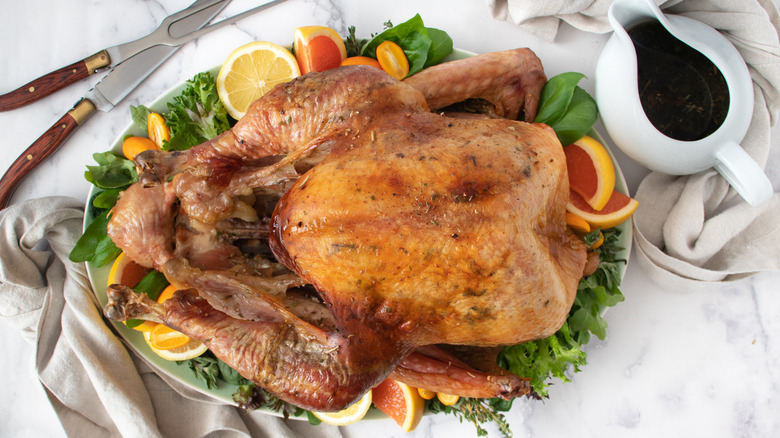
Ingredients
- 1 (12-pound) whole turkey
- ¼ cup kosher salt
- 2 tablespoons brown sugar
- 1 teaspoon black pepper
- 1 teaspoon granulated garlic
- 1 teaspoon dried rosemary
- 1 teaspoon dried thyme
- 1 teaspoon dried chives
Optional Ingredients
- 3 cups stock (to make gravy)
Directions
- Remove and discard the turkey neck and giblet bag (or save them for gravy).
- Place the turkey on a wire rack-lined roasting pan and pat it dry with paper towels.
- Loosen the skin around the breast and legs using your hands and fingers, being careful not to puncture the skin.
- Add the salt, brown sugar, pepper, garlic, rosemary, thyme, and chives to a medium bowl and stir to combine.
- Divide the dry brine mixture, saving ½ to use under the skin, ¼ for over the skin, and another ¼ to sprinkle in the cavity.
- Rub the brine into the turkey starting under the skin, doing your best to thoroughly coat the meat.
- Then, rub the skin with the brine, followed by the cavity.
- Place the seasoned turkey in the refrigerator uncovered and allow it to brine for 3 days.
- Once brined, remove the turkey from the refrigerator, letting it rest at room temperature for 1 hour before roasting.
- At the 15-minute mark, preheat the oven to 425 F.
- Roast the turkey for 20 minutes then reduce the oven temperature to 350 F and continue to roast for 2 ½ to 3 hours, checking at about the 1 ½ hour mark. If you want to make a gravy or jus, drizzle the stock over the turkey after the 1 ½ hour mark. If your bird is getting dark in spots, loosely cover that area with some aluminum foil.
- The turkey is ready once the internal temperature reaches 160 F. (Insert the thermometer into the thickest part of the breast away from the bone to check.)
- Once your turkey has reached 160 F, remove it from the oven and set it aside to rest for 30 minutes before slicing and serving.
Nutrition
| Calories per Serving | 702 |
| Total Fat | 27.3 g |
| Saturated Fat | 7.1 g |
| Trans Fat | 0.3 g |
| Cholesterol | 347.8 mg |
| Total Carbohydrates | 3.5 g |
| Dietary Fiber | 0.2 g |
| Total Sugars | 2.6 g |
| Sodium | 1,590.2 mg |
| Protein | 104.7 g |
